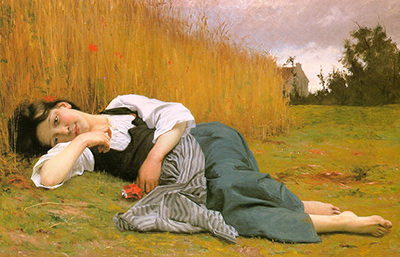William Bouguereau painted Rest in Harvest in 1865. This fine example of Neoclassicism is typical of the artist. His use of colour is superb and will delight fans of Realism in art.
The richness of the fields is displayed in bold, beautiful hues of orange. This demonstrated the bounty that was likely to be obtained by the women as they worked.
The painting depicts a woman at leisure in an open section of a field. The area in which she is resting is verdant. Her eyes are open as she stares at the viewer. The pastoral scene is one that would be at home in virtually any setting. It is easy to relate to the peace of the scene. Bouguereau paints the grass as only he can. The texture looks so soft that some may wish they could step barefoot into the painting and feel it under their feet.
The artist's grasp of anatomy is excellent and even the model's toes are rendered in detail. The position of her body emphasises her state of rest and one arm has an extra layer of colour which matches that of the setting sun. Although Bouguereau is a painter who uses Realism, this element of colour adds a touch of fantasy to the scene, since it is unlikely that the hand resting across her body would have that colour. His colour selection reinforces her state of rest.
William Bouguereau's Rest in Harvest captures the beauty of a time of recovery that is well deserved. After the hard work of gathering crops to be distributed to other people, those who have spent all day in the field need to spend some time recuperating. This is a time that is unlike the rest take out of habit or because someone has nothing else to do. It is a rest of reward, marked as the end to a time that is in reality, possibly only a brief pause before work begins anew.
His focus on a single worker instead of a group is interesting. Perhaps he considered it important to examine more details of a single person at rest than those of a group. This artist also has a preference for painting no more than two people.




